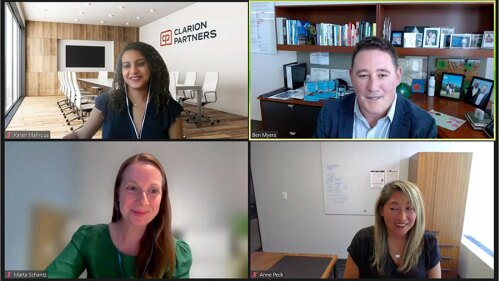Hotels and office buildings are takingon many of each other’s characteristics in terms of design and use. This confluencehas several drivers, among them the evolution of technology, shifts in guestand tenant expectations, and the increasing mobility of the American workforce.
More and more professionals are travelingor freelancing, using hotel rooms, lobbies, cafés, and restaurants as theirthird place for working and meeting. Even the most traditional users of officespace—such as attorneys and accountants—are emerging from cubes and closed-doorspaces to find nontraditional ways of working. Add “bleisure” travel into themix, where business and leisure time are blended into one trip, and it is logicalthat the traditional approach to hotels and offices must evolve and has been.
When describing partnerships, a wiseman (and the author’s father)—John Scovell, who started Woodbine DevelopmentCorporation some 45 years ago—once said that you should always look for thoserelationships where one plus one equals more than two. With Woodbine’s mostrecent project in L.A., finding the ways that hotel and office spaces canbenefit each other seems to be in line with his formula.
In recent years, hotels have been addingboth informal and formal coworking spaces to their setups, cultivating communalspaces where visitors can take care of business, be social, or both. InChicago, Virgin Hotels has taken a business approach to coworking, creating theVirgin Commons Club, offering monthly memberships that provide access toamenities such as free drinks, a library, a bar, private meeting areas, wi-fi,and wireless printing. Ace Hotels in New York City has taken a more a leisurelyapproach, creating inspiring lobbies and gathering spaces where interestingpeople want to be. Rather than seeking revenue from membership fees, Ace focuseson the multifaceted benefits of having people in the hotel: interesting peopleactivate the lobby of the hotel, ultimately building brand awareness and drivingincremental food-and-beverage revenue. Regardless of the approach taken, office-inspiredis becoming an increasing popular feature inside hotels—and one that can beprofitable.
Office spaces and building owners havebeen getting increasingly creative—and more research is being done in thisspace to inform that creativity (e.g., Gensler’s recent workplace survey). Propelledlargely by the global expansion of WeWork, office space has begun to take on anentirely new personality. WeWork and other coworking companies like Spaces andCBRE’s Hana are essentially building hotel lobbies flanked by small officesthat spur opportunity for collaboration and innovation. Such atmospheres wereonce considered to be the stuff of startups that were lacking street cred orthe actual credit needed to secure a long-term lease. Now, all types ofcompanies—including the likes of Microsoft, Salesforce, Adidas, and others—areseeking enterprise solutions with their office environments, which include diverselayouts as well as an infusion of hospitality-inspired amenities and services.JLL cites that coworking/flexible space has become the primary driver in thegrowth market, growing at an annual rate of 23 percent since 2010. It alsopredicts that flexible workspace and amenity space, which currently makes up 5percent of the market, will reach 30 percent by 2030.
Woodbine Development Corporation and LincolnProperty Company have been tracking these trends for years and looking for theright place to implement it—Woodbine for hotel and Lincoln for office space. Amatch made in Dallas, the companies joined forces through their L.A. teams andstarted looking for the right property that would allow them to realize theirvision for a twist on what was trending: the creation of a collaborative hoteland office space.
That vision is now becoming a reality inL.A.’s Westside. The project is located in a highly visible area situated withinL.A.’s two strongest innovation hubs, including the highly sought-after submarketsof Culver City and Playa Vista. Woodbine purchased the Doubletree L.A.-Westsidein 2018 for $151.5 million, which came with a 2.2-acre (0.9 ha) parking lotentitled for a new, class A office development, which it turned around and soldto Lincoln. Together, the two companies—along with Goldman Sachs and Gensler—arecreating the first collaborative hotel and office arrangement of its kind inthe City of Angels.
The DoubletreeL.A.-Westside first caught Woodbine’s eye in 2011. Theproperty had been recently convertedfrom a Radisson to a Doubletree. Even though the name on the buildingchanged, the property remained an unremarkable airport hotel on the border ofCulver City, home of Sony Studios, and Playa Vista, which was then a mixed-use,master-planned community still working to realize its potential.
At the same time, Lincoln was quicklybecoming the most active commercial developer in Playa Vista, delivering nearly2 million square feet (185,800 sq m) of office and mixed-use development. Theoffice buildings were being leased to high-quality media and technologycompanies, including Fox Studios, Samsung, and the Honest Company, to name afew. In addition, Lincoln developed a new West Coast entertainment headquartersfor IMAX and had launched several other projects in Culver City in 2017, amongthem the new Apple Media Headquarters at 8777 Washington, which coincided withthe rapid absorption of new and renovated office and production studiosheadlined by Amazon, HBO, and others. Meanwhile, Woodbine was renovating theHilton Pasadena and, in 2017, launched Woodbine Legacy Investments, a realestate fund through which it acquired Hilton Dallas/Park Cities and WAtlanta-Buckhead.
Given their portfolio combined experience, the Woodbine and Lincoln teams viewed the Doubletree and the 2.2-acre (0.9 ha) parking lot entitled for office development as a diamond in an evolving rough. The hotel was also less than two miles (3.2 km) from Los Angeles International Airport, with its annual passenger count of nearly 100 million—not to mention the hotel’s proximity to the new L.A. Stadium, which will be home to both the L.A. Rams and San Diego Chargers. With its Culver City address, the potential office would offer residents, visitors, and office users like Google, Facebook, Sony, and YouTube an ideal environment with proximity to Marina Del Rey, Venice Beach, Santa Monica, and El Segundo, all markets experiencing increasing amounts of office compression.
The economy across the L.A. market hadstarted to diversify with an influx of tech and media companies—spurringgrowth, transformation, and reconfiguration across the metro area, making theeasily accessible Culver City and coastal Playa Vista markets more and more ofa draw. Rob Kane, executive vicepresident for LPC West, the Western division of Dallas-based Lincoln PropertyCo. and Woodbine’s partner on the deal, adds that the hotel’s location off the405 freeway places the project directly in the center of these two submarkets,which are two of the most dynamic submarkets in Los Angeles. Occupancy is fullin both cities, making the Doubletree project well timed.
In 2016, Woodbine and Lincoln were ableto navigate a very competitive bidding process and get control of the Doubletreeand adjacent parcel. But due diligence findings aroundentitlements ultimately took the deal off the table. Fortunately, Woodbineremained on good terms with the seller and was able to get a second bite at theapple, thanks in large part to Patrick Deming and Andrew Holt of EastdilSecured, who were serving as the seller’s advisers. In March 2018, Woodbine wasprepared to move quickly with a longstanding lending relationship in tow. Itpurchased the hotel and adjacent parcel, Entrada, a few months later for $151.5 million through Woodbine LegacyInvestments. Shortly thereafter, itsold the 2.2-acre (0.9 ha) parcel to Lincoln in a codevelopment venture. Woodbineis a partner on the office project, as is Goldman Sachs. Gensler serves as thearchitect/design firm for the office building and HBA is the interior designfirm for the hotel.
Both Doubletreeand Entrada stand to benefit from each other’s presence—with the sum beinggreater than the parts to give the twoproperties a competitive advantage in the marketplace.
Underway now, Woodbine’s $35 millioninvestment in the Doubletree will transform public spaces, the exterior facade,and landscaping, and 25,000 square feet (2,300 sq m) of meeting space toreflect the needs of today’s travelers and the surrounding modern,fast-growing, tech-forward neighborhood. All 375 guest rooms and guest bathswill also be updated and outfitted with new furnishings, surfaces, lighting,and decor. Amenities such as the fitness center, pool, Share Bistro, Share WineLounge, and more will also be upgraded. Woodbine will also integrate adedicated coworking space into the hotel, which will be available to guests,Entrada tenants, and nearby residents.
With accessto all the amenities of the Doubletree (likely automated and accessible via anintegrated app in conjunction with support from the hotel team), the Entradahas been designed to feature expansive views, dynamic indoor/outdoorenvironments including a large, landscaped amenity deck, floor-to-ceiling glasswith flexible floorplates, a spacious lobby and a generous parking supply, andunmatched opportunities for tenant signage and identity off the 405 Freeway. Theoffice will break ground in the third quarter of this year. The hotel’s adjacencyto the office project has allowed for the design of a more efficient building witha higher ratio of rentable square footage. This also leaves room for theintegration of the aforementioned features, such as accessibility to the greatoutdoors, which is appealing in Southern California and especially so among thetypes of tenants flocking the area. Every office floor will have two open-air decksbuilt into the interior of the structure, allowing people to work outside whilealso enjoying being outdoors. Entrada will also have retail amenities on theground floor to benefit tenants and hotel guests as well as locals in thecommunity.
When finished in 2020, Doubletree andEntrada will stand out for passersby on the 405, and they will also be astandout for those on the ground looking for a place to work, stay, or play. Thereis nothing else like this setup in the West L.A. market, Kane says, which is exactlywhy Woodbine and Lincoln are taking it there.







